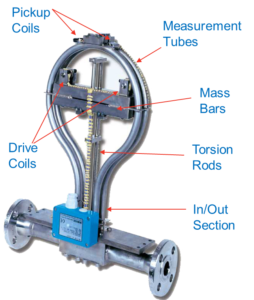Rheonik, The Leading Coriolis Flow Meter Design
Rheonik built the leading Coriolis flow meter design because it provides a range of advantages above the limitations of their counterparts. For more about the history, theory and limitations of competitive Coriolis meters, check out our companion blog “Understanding Coriolis Meter Technology”. For now, let’s examine the common and differing parts of the Rheonik Coriolis flow meter versus the competition:

- First, common parts include the pick-up coils mounted on the tubes, dual tube construction and drive coils.
- Next, notice the drive coils mounted on the mass bar rather than the tubes. As shown in the graphic, the full assembly features an omega shape.
- Note, that unlike the commonly utilized meters with U-tube or Diamond shaped styles, this instrument contains a mass bar and torsion rod.
What is it about these differences that make Rheonik the leading Coriolis flow meter?
The mass bar performs some essential functions.
- One, the mass bar isolates the measurement section above it from the process born disturbances occurring around an installation and provides tube support. The bottom of the tubes simply serves as a fluid delivery system.
- Second, drive coils mounted on the mass bar drive the tubes at higher amplitude. It ensures symmetrical acceleration and deceleration which powers through process born disturbances like noise and aeration.
- In contrast, simple U-tube or diamond shaped designs function in abrupt operation mode driven apart and then snapping back together repeatedly without any support.
The torsion rod stores and releases energy yielding several advantages:
- Most importantly, it generates a higher signal to noise ratio than other Coriolis meters with less power usage. In fact, the entire range from 1/16” to 12” requires low power with an intrinsically safe circuit.
- Because the supported tubes, driven by the coils and torsion rod, produce greater amplitude, it enables Rheonik to manufacture the instruments with thick wall tubes in nearly any alloy.
Thick wall tubes give Rheonik the edge as the leading Coriolis flow meter.
- First and foremost, the range of alloys combined with thick wall tubes allows Rheonik to solve high pressure applications above 20k PSI in the small meters and above 8k PSI in the medium to large meters.
- Because of thick wall tubes, no special runs of thin wall tubes required or additional engineering to incorporate them.
- In addition, Rheonik enjoys shorter lead times with tubing that matches the piping specification.
- Last but not least, thick wall tubes need no secondary containment.
The Omega shape matters.
- Indeed, the omega shape makes the meter resilient to deformation caused by pressurization. Alloys naturally bend to a semi-circular form when pressurized exposing other shapes to deformation at high pressures.
- As a rule, “zeroing” a Coriolis meter establishes the frequency at zero flow. To zero the omega meter, simply fill the process line with fluid or gas and then calibrate the zero point. Other designs need the blocked in process fluid at pressure to accomplish a good zero point.
- Because the tubes gather at the in/out section, it reduces inaccuracies caused by temperature variations and torqueing of the tubes from misaligned piping or installation errors.
Summary of reasons why Rheonik is the leading Coriolis flow meter design
Rheonik Design
- High pressure capable with wide alloy selection
- Thick wall tubes with higher corrosion / erosion allowance
- Drives through external vibration and process borne dampening conditions like aeration
- Minimal signal manipulation – mechanically sound method
- Stores energy – efficient and low powered (IS)
- Produces greater amplitudes and strong signal to noise ratio for improved accuracy
Other Designs
- Use thin walled tubes
- Achieves limited pressure ranges with reduced alloy selection
- Contains no measurement tube support
- Tubes susceptible to external process born disturbances and misaligned piping
- High energy usage
- Abrupt operation mode
In conclusion, Rheonik produced a truly balanced oscillation system. Moreover, the company focuses on continual innovation to develop new designs and improve existing technology. Innovations led to their high pressure capable version above 20K PSI, high temperature meters, exotic materials selection and the added flexibility of customizable process connections for demanding niche applications. Reach out to our team of experienced engineers to assist with your next project!
